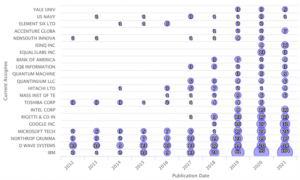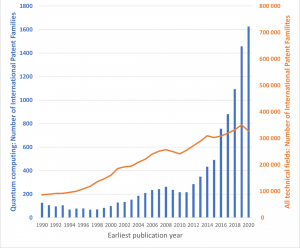 Introduction
Introduction
The field of quantum computing demonstrate a paradigm shift in the world of technology and innovation. As quantum computers progress at an unprecedented pace, they present new challenges and opportunities in the area of intellectual property (IP). This article delves into the relationship between quantum computing and IP, exploring the patent landscape and the legal issues for this cutting-edge technology.
Quantum computing derives its constituent elements from principles of quantum mechanics (e.g., superposition, entanglement and tunnelling), the theory of the very small [1]. Quantum computing, with its potential to revolutionize computation and problem-solving, has captured the attention of scientists, researchers, and innovators alike. As quantum computing technology matures, the intellectual property landscape is evolving in tandem, offering a fascinating intersection of scientific innovation and legal challenges. Quantum computers can be protected by different types of intellectual and industrial property rights, such as chip rights (semiconductor topography protection) and patents[2].
What is Quantum Computing?
In classical computing, data is typically encoded in lengthy sequences of bits. A bit represents the smallest unit of data and can only take on one of two distinct values, either 0 or 1. This allows for the execution of numerous operations as needed. This encoded data is transmitted to a processing unit where it is deciphered and interpreted as electrical signals. An electrical signal of 0 represents an “off” signal, while a signal of 1 represents an “on” signal. Basic logical circuits are employed to determine how to reorganize the numerical data in order to produce a desired outcome or result. Crucially, classical computers perform operations deterministically, meaning that a specific input always results in the same output.
In contrast, quantum computing operates by utilizing qubits (quantum bits) rather than classical bits. Similar to classical bits, qubits can have a value of either 0 or 1 when measured. However, while computing, qubits can exist in a quantum mechanical “superposition” of both states, allowing them to be considered as 0 and 1 simultaneously. In essence, quantum computing exploits the probabilistic principles of quantum mechanics for executing operations, in contrast to utilizing conventional deterministic processes.
What Quantum Computer is capable of?
Many companies are using quantum computing to enhance their technologies. Figure 2 illustrates a significant increase in the use of quantum computing. It also displays the leading owners of patents for quantum computers. In general, quantum computing is ideally suited for solving mathematical optimization problems, solving some of the computationally hard problems on which we build current cryptography [3], and simulating the behavior of atoms and elementary particles. Quantum computers are useful when modelling nature [4] or searching large amounts of data using parallel quantum query algorithms [5]. They excel when complex systems have to be simulated. Quantum machines also have limits. Quantum computers can help finding approximate solutions to computational complexity NP-hard and NP-complete problems, such as the travelling salesman problem[1] [6]. Figure 3, which compares the growth of quantum computing patents with other technical patent types on an international scale, also shows that the technologies that tend to use quantum computing are growing.
Patents and Quantum Computing
Quantum patents are patents with claims relating to quantum computing. As shown in figure 1, the number of quantum patents granted by the USPTO is rapidly increasing each year [7].
The following components are eligible for patent protection: the technology building blocks (qubits), quantum gates and multipliers, quantum integrated circuit chips, the various types of quantum processors such as spin qubits and superconducting transmon qubits, quantum interference devices, compiler engines (i.e., optimizers, translators and mappers), decoders, the simulator and the emulator, the circuit drawer, the microarchitecture (QEX block and QEC block), the quantum–classical interface, the quantum instruction set architecture and quantum memory [8]. Quantum computing algorithms are not patentable as such since they are pure mathematical methods (i.e., abstract ideas). However, the application of quantum algorithms to solve specific technical problems can potentially be patent eligible [9].
[1] The traveling salesman problem (TSP) is a widely recognized problem in combinatorial optimization. Its aim is to identify the shortest possible route that connects a predetermined set of cities and returns to the starting point, while visiting each city precisely once. The TSP has diverse practical applications in fields such as logistics, transportation, and manufacturing.

Figure 1. Displays patents classified by the USPTO and EPO graphed based on the date of patent grant publication [9].

Figure 2. Top patent quantum computer owners and evolution of patenting activity

Figure 3. Quantum computing: number of international patent families, per earliest publication year [10].
The rapid development of quantum computing technology has led to a race to secure patents in this field. Companies, universities, and research institutions are filing patents for quantum algorithms, hardware designs, quantum processors, and quantum software.
Examples of Patents and Quantum Computing
The innovations in the realm of quantum computing span diverse areas, showcasing the evolving landscape of this cutting-edge technology. A notable development is the introduction of a novel programming architecture for quantum computers (CN108734302A), characterized by specific classes that decompose quantum computer operations. This innovation facilitates efficient quantum software development, ensures portability across various hardware architectures, and supports high-level quantum languages, enabling the implementation of classical-quantum crossover algorithms. Another groundbreaking advancement involves the creation of a Hybrid Quantum-Classical (HQC) computer system (CA3112444A1), which intelligently combines classical and quantum computing elements to solve linear systems. By breaking down the linear system into manageable subsystems, the quantum computer, under classical control, collaborates with the classical computer to synthesize outputs and generate complete solutions.
In the field of quantum machine learning, a method and system have been introduced for determining the fairness of quantum machine learning algorithms (CN115329968A). This innovative approach involves calculating fairness rates based on characteristic values, providing an objective assessment of whether a quantum machine learning algorithm meets user requirements. Furthermore, there have been advancements in resource-efficient quantum error correction technologies (WO2020180902A), optimizing quantum computer performance. By coupling physical gate qubits with a quantum memory possessing lower error rates, the quantum computer achieves efficient error correction for a large number of logical qubits. Lastly, a quantum computer operating system has been designed (CN114912620A), featuring a quantum program compilation optimization module that streamlines the execution of quantum programs. This operating system obtains quantum programs, compiles tasks based on quantum chip topologies, and communicates these tasks to quantum computing hardware, enhancing the overall efficiency of quantum computations.
Conclusion
Quantum computing is pushing the boundaries of what’s possible in technology and innovation. As it upends traditional computing paradigms, it’s also reforming intellectual property norms and practices. The patent landscape is evolving, ethical dilemmas are emerging, and security concerns are becoming a pressing issue. Navigating the intersection of quantum computing and intellectual property requires a delicate balance between fostering innovation and ensuring accessibility, security, and fairness in this new era of computing.
For in-depth insights on the intersection of Intellectual Property (IP), we invite you to explore the MNIP library.
Referências
| [1] | M. M. A. a. T. M. Kop, “Intellectual property in quantum computing and market power: a theoretical discussion and empirical analysis.,” 2022. |
| [2] | M. Kop, “Quantum computing and intellectual property law.,” 2022. |
| [3] | M. v. Heesch, “Cyber security through quantum-safe crypto”. |
| [4] | A. Ambainis, “What Can We Do with a Quantum Computer?,” 2014. |
| [5] | F. M. &. R. d. W. Stacey Jeffery, “Optimal Parallel Quantum Query Algorithms,” 2017. |
| [6] | M. OpenCourseWare, “The limits of quantum computers,” 2008. |
| [7] | B. Haney, “Quantum patents,” 2021. |
| [8] | M. M. A. a. T. M. Kop, “Intellectual property in quantum computing and market power: a theoretical discussion and empirical analysis,” 2022. |
| [9] | T. a. M. A. Minssen, “The patentability of computer-implemented simulations and implications for computer-implemented inventions (CIIs).,” Journal of Intellectual Property Law & Practice, 2021. |
| [10] | HPCwire, 2023. [Online]. Available: https://www.hpcwire.com/off-the-wire/european-patent-office-publishes-patent-insight-report-on-quantum-computing/. |
